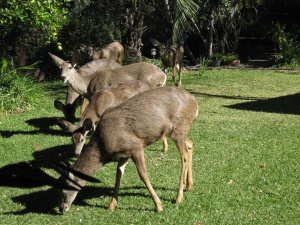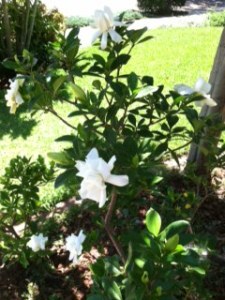 We are lucky to be living in a deer-friendly neighborhood. This is fawn season and a doe has brought her two spotted fawns into our backyard at least three times that I’ve noticed. Undoubtedly more often. I figure she’s teaching them how to drink from birdbaths and which yards have the tastiest leaves.
We are lucky to be living in a deer-friendly neighborhood. This is fawn season and a doe has brought her two spotted fawns into our backyard at least three times that I’ve noticed. Undoubtedly more often. I figure she’s teaching them how to drink from birdbaths and which yards have the tastiest leaves.
Therein lies a problem.
We would delight in the occasional deer (mule deer) to our unfenced yard. Then we began to notice that the rose bushes had fewer flowers, the tomatoes disappeared on the plants as soon as they started to turn red and the pansies were bitten off the day after we planted them. I tried spraying the plants with a raw egg/water mixture (I read that in a book) and it seemed to work until the first rain. We also tried powdered garlic on the plants with limited success. We even considered human urine as a way to mark the territory as “ours” but ultimately we accepted that if we wanted to enjoy our wildlife visitors, we’d have to make concessions.
The deer numbers have increased. What used to be an occasional sighting has become a common occurrence. We surrendered to a dearth of flowers, bushes stripped of leaves (at least to the deer-mouth height of about 4 feet) and our envy of other deer-empty neighborhoods filled with colorful variety.
 Then we noticed something interesting. Deer discriminate. Whereas roses and azaleas are toast, succulents are eaten primarily when other choice plants are unavailable And gardenias? Not at all.
Then we noticed something interesting. Deer discriminate. Whereas roses and azaleas are toast, succulents are eaten primarily when other choice plants are unavailable And gardenias? Not at all.
Our mule deer also avoid springtime narcissus, daffodils, iris and gladiolus. Sage and lavender also survive.
Hey, we may be on to something here. I don’t mind our yard being the deer’s salad bar as long as they leave me something. It’s all about sharing. And watching spotted fawns frolic in the backyard.
